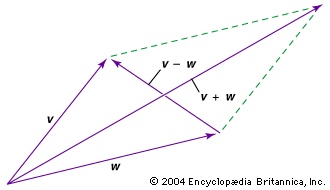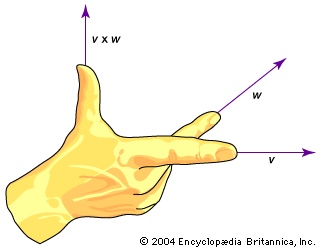vector
mathematics
in mathematics, a quantity that has both magnitude and direction but not position. Examples of such quantities are velocity and acceleration. In their modern form, vectors appeared late in the 19th century when Josiah Willard Gibbs (Gibbs, J Willard) and Oliver Heaviside (Heaviside, Oliver) (of the United States and Britain, respectively) independently developed vector analysis to express the new laws of electromagnetism discovered by the Scottish physicist James Clerk Maxwell (Maxwell, James Clerk). Since that time, vectors have become essential in physics, mechanics, electrical engineering, and other sciences to describe forces mathematically.
Vectors may be visualized as directed line segments whose lengths are their magnitudes. Since only the magnitude and direction of a vector matter, any directed segment may be replaced by one of the same length and direction but beginning at another point, such as the origin of a coordinate system. Vectors are usually indicated by a boldface letter, such as v. A vector's magnitude, or length, is indicated by |v|, or v, which represents a one-dimensional quantity (such as an ordinary number) known as a scalar. Multiplying a vector by a scalar changes the vector's length but not its direction, except that multiplying by a negative number will reverse the direction of the vector's arrow. For example, multiplying a vector by 1/2 will result in a vector half as long in the same direction, while multiplying a vector by −2 will result in a vector twice as long but pointed in the opposite direction.
 Two vectors can be added or subtracted. For example, to add or subtract vectors v and w graphically (see the diagram-->
Two vectors can be added or subtracted. For example, to add or subtract vectors v and w graphically (see the diagram--> ), move each to the origin and complete the parallelogram formed by the two vectors; v+w is then one diagonal vector of the parallelogram, and v−w is the other diagonal vector.
), move each to the origin and complete the parallelogram formed by the two vectors; v+w is then one diagonal vector of the parallelogram, and v−w is the other diagonal vector. There are two different ways of multiplying two vectors together. The cross, or vector, product results in another vector that is denoted by v×w. The cross product magnitude is given by |v×w|=vw sinθ, where θ is the smaller angle between the vectors (with their “tails” placed together). The direction of v×w is perpendicular to both v and w, and its direction can be visualized with the right-hand rule, as shown in the figure-->
There are two different ways of multiplying two vectors together. The cross, or vector, product results in another vector that is denoted by v×w. The cross product magnitude is given by |v×w|=vw sinθ, where θ is the smaller angle between the vectors (with their “tails” placed together). The direction of v×w is perpendicular to both v and w, and its direction can be visualized with the right-hand rule, as shown in the figure--> . The cross product is frequently used to obtain a “normal” (a line perpendicular) to a surface at some point, and it occurs in the calculation of torque and the magnetic force on a moving charged particle.
. The cross product is frequently used to obtain a “normal” (a line perpendicular) to a surface at some point, and it occurs in the calculation of torque and the magnetic force on a moving charged particle.The other way of multiplying two vectors together is called a dot product, or sometimes a scalar product because it results in a scalar. The dot product is given by v∙w=vwcosθ, where θ is the smaller angle between the vectors. The dot product is used to find the angle between two vectors. (Note that the dot product is zero when the vectors are perpendicular.) A typical physical application is to find the work W performed by a constant force F acting on a moving object d; the work is given by W=Fdcosθ.
physics
in physics, a quantity that has both magnitude and direction. It is typically represented by an arrow whose direction is the same as that of the quantity and whose length is proportional to the quantity's magnitude. Although a vector has magnitude and direction, it does not have position. That is, as long as its length is not changed, a vector is not altered if it is displaced parallel to itself.
In contrast to vectors, ordinary quantities that have a magnitude but not a direction are called scalars (scalar). For example, displacement, velocity, and acceleration are vector quantities, while speed (the magnitude of velocity), time, and mass are scalars.
To qualify as a vector, a quantity having magnitude and direction must also obey certain rules of combination. One of these is vector addition, written symbolically as A+B=C (vectors are conventionally written as boldface letters). Geometrically, the vector sum can be visualized by placing the tail of vector B at the head of vector A and drawing vector C—starting from the tail of A and ending at the head of B—so that it completes the triangle. If A, B, and C are vectors, it must be possible to perform the same operation and achieve the same result (C) in reverse order, B+A=C. Quantities such as displacement and velocity have this property ( commutative law), but there are quantities (e.g., finite rotations in space) that do not and therefore are not vectors.
The other rules of vector manipulation are subtraction, multiplication by a scalar, scalar multiplication (also known as the dot product or inner product), vector multiplication (also known as the cross product), and differentiation. There is no operation that corresponds to dividing by a vector. See vector analysis for a description of all of these rules.
Although vectors are mathematically simple and extremely useful in discussing physics, they were not developed in their modern form until late in the 19th century, when Josiah Willard Gibbs (Gibbs, J Willard) and Oliver Heaviside (Heaviside, Oliver) (of the United States and England, respectively) each applied vector analysis in order to help express the new laws of electromagnetism, proposed by James Clerk Maxwell (Maxwell, James Clerk).
- rain shadow
- Rainwater, James
- Rainy Lake
- Raipur
- Raisa Smetanina
- raised work
- Raisen
- Rais, Gilles de
- raisin
- raisin tree
- Raitt, Bonnie
- Raja Ali Haji bin Raja Amhad
- Rajagopalachari, Chakravarti
- Raja Haji
- Rajahmundry
- Rajang River
- Rajapalaiyam
- Raja Rao
- Rajasthan Steppe
- Rajauri
- Rajaʾi, Mohammad Ali
- Rajendra Prasad
- Rajgarh
- Rajgir Hills
- Rajiv Gandhi